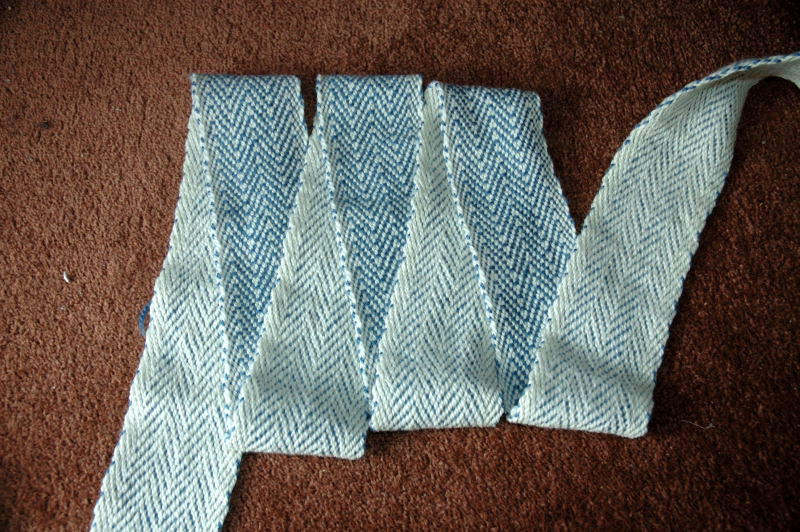
I know, the background colour isn't great for this...
Old:
Width - 85mm
ppi - approx 32/4"
stretch - 50cm unstretched to 57cm stretched

New:
Width - 82mm
ppi - approx 31/4"
stretch - 50cm unstretched to 56/57cm stretched
I think the conclusion I can reach here is that the wool itself is extremely stretchy. I could possibly do more experimenting and come up with slight differences, but given that there was a couple of years between the two pieces of weaving I don't think I can really conclude that there is any real difference between these pieces. The actual weaving process is quite different. To try and get the same weft density on the table loom I had to use a denser sett on the selvedges, and then I still had to beat very lightly. On the warp weighted piece the warp density is actually lower towards the edges - I suspect that this is mostly through inexperience with a warp weighted loom.
I think both looms have their particular advantages and quirks, depending on the project. The warp weighted loom has (in some ways) more flexibility than the horizontal loom. It theoretically has an unlimited number of shafts, and with a clever tie up can have warp threads attached to more than one heddle rod (this is one of those things that messed me up when I was trying to tie the heddles on the 2-2 twill currently on it - it took me a couple of attempts to work it out). I guess you could think of it as having an infinite number of shafts, with the heddle rods being a treadle equivalent. Too many will get confusing, but you can use as many as you like at one time. It's much harder to change the tie-up though.
Probably my favourite part is that you don't have to wind the warp onto anything, and tension is much less hassle. The downside is that you have to move the weights, which I think would get pretty annoying on a wide cloth.
The horizontal loom is a more sophisticated machine. It has a lot of added features that help to make a good, reliable end product. The reed helps to get a tighter beat, as well as holding your cloth at (or at least close to) a fixed width. (You can kind of do this on the warp weighted loom by fixing the spacing on the heddles, but it's not as neat). The threading is a lot faster, and I think it's also easier to fix mistakes. You are limited to however many shafts you have built in, but I guess you could add heddle bars to a horizontal loom too...
You have to wind the warp onto the back beam too, which is my least favourite part. The weaving is also a lot faster, which I think is the biggest advantage.
So overall, the same result appears to be achievable with both looms. The stretch in the original band appears to be entirely due to the elasticity of the yarn. Which I guess really means that I don't really need to build a full size warp weighted loom.
2 comments:
I think what you've discovered is that aside from speed, replicability is in the skill of the weaver!
I'd very much like to see more of the warp-weighted loom some time, and how you go about weaving on it.
Fascinating read. I feel I almost have to experiment myself to understand this post fully... Maybe in 2010?
Post a Comment